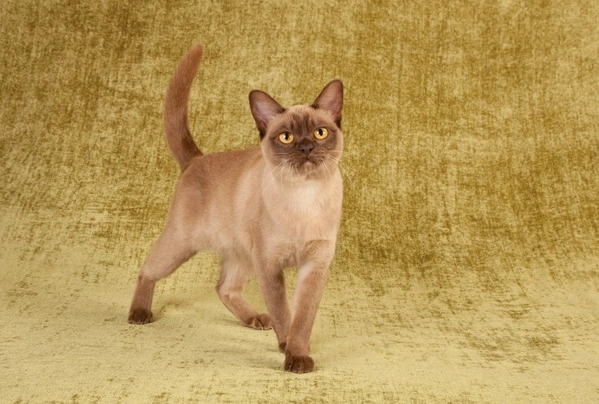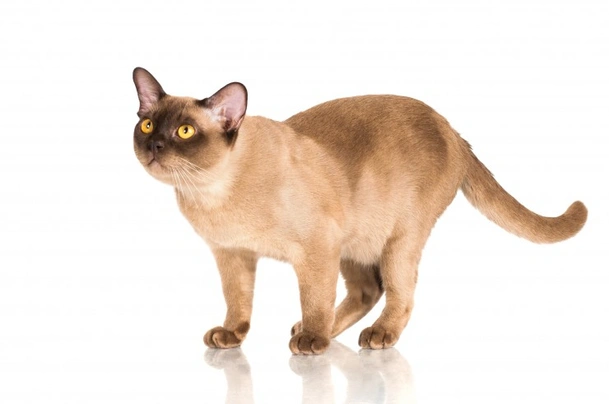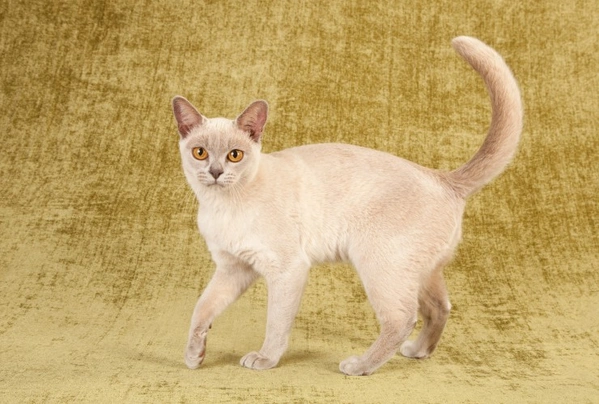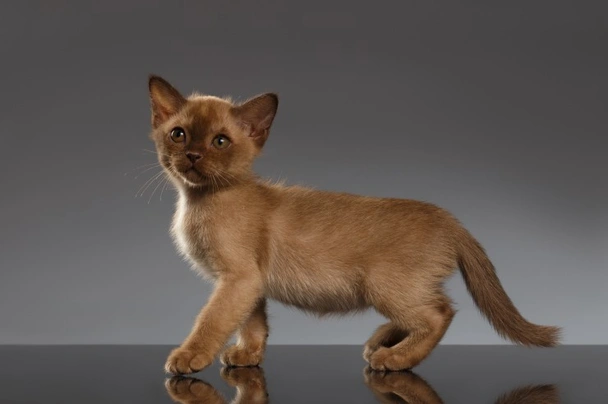Burmese
Introduction of the Burmese
The Burmese cat is known to have a very dog-like personality loving nothing more than to follow owners around the home and being involved in everything they are doing. It’s their way of getting all the attention they crave while at the same time showing owners just how much they love them. They are strong athletic and graceful cats that boasts wonderful glossy coats. Males tend to be quite a bit larger than their female counterparts but both are loyal and affectionate which are just two of the reasons why the Burmese has remained such a popular companion and family pet throughout the ages.
History of the Burmese
Although the Burmese was originally native to Burma the cats we see today were developed in the United States. Legend has it that ancestors of the breed were considered sacred and were kept in remote monasteries and temples in Burma. It is said the cats were so revered they were given their own servants whose task it was to look after them and to make sure no harm ever came to them.
It was in the late 1800s that the breed found its way to England although at the time they were never as popular as their blue-eyed cousins the Siamese. As a result their numbers fell to dangerously low levels both in the UK and Europe. However in the thirties breed enthusiasts rescued the Burmese by Dr Joseph Thompson a medical officer who was serving in the US navy when he returned to the States after his tour of duty. He established a breeding programme using pure breeds to widen the gene pool.
In 1936 the breed was officially recognised by the Cat Fancier's Association (CFA) and then in 1952 the Burmese was officially recognised by the GCCF in the UK and was granted full Championship status a few years later in 1959. Today the Burmese is among one of the more popular breeds both in the UK and elsewhere in the world thanks to their charming looks and affectionate playful and loyal natures.
Appearance of the Burmese
The Burmese is a strong elegant and athletic cat that boasts having a lovely glossy coat. Their coats always appear to have a polished look about them which is one of the breed’s distinguishing traits. Although athletic the Burmese is quite a heavy cat yet their legs are nice and slender. They have wedge-shaped heads that are well rounded at the top. Their ears are medium in size set well apart and rounded at the tips matching the shape of their heads. They have large eyes which can be anything from a bright yellow right through to amber in colour and which are set well apart. Cats always have a keen alert expression in their eyes which adds to their charming looks. They have wide cheek bones and quite blunt noses with a clear break in them. Males have more well developed jowls and thicker necks than their female counterparts.
They have moderately long well-muscled bodies and nice strong chests which when seen in profile appears rounded. Backs are straight from a cat's shoulders to their rumps. They have slender legs with their back ones being slightly longer than their front legs. Their paws are oval in shape and small. The Burmese has a straight tail that's thicker at the base before it tapers to a rounded tip.
When it comes to their coat the Burmese boasts having a short fine close lying glossy coat that's very satin-like to the touch. The sheen on a cat's coat is always thought to be a sign of them being in good health. The colour on their under parts is always that much lighter than on the rest of their bodies but the change in colour is always gradual and never abrupt. A cat's ears and face can also be slightly darker and some Burmese have slight tabby markings on their faces as well as undefined markings on the rest of their bodies with the exception of on their sides and bellies. Coat colours include the following:
- Brown
- Blue
- Chocolate
- Lilac
- Red
- Cream
- Brown Tortie
- Blue Tortie
- Chocolate Tortie
- Lilac Tortie
Temperament of the Burmese
The Burmese is renowned for being a cuddly affectionate and fun-loving cat that loves being part of a family. They crave human contact liking nothing more than being involved in everything that goes on in their environment. They are quite gregarious and extremely social by nature and as such they need to be kept busy to avoid boredom setting in. They get on very well with children which is another reason why they are such a great family pet.
They boast having a soft albeit rather "hoarse" voice and can be quite talkative at times especially when encouraged. They don't like to be left on their own for long periods of time which means they are best suited to families where at least one person stays at home when everyone else is out. Males tend to be less inquisitive than their female counterparts and they are often a lot quieter by nature too. Females on the other hand tend to get very attached to their families and crave more in the way of attention. However both females and males are known to like their food a little too much which is why it's important to keep an eye on a cat's waistline throughout their lives.
Intelligence / Trainability of the Burmese
The Burmese is a highly intelligent cat and one that boasts having a ton of energy. They are often referred to as being the "extroverts" of the cat world which often sees them behaving very mischievously. Because they are so smart and boast so much energy the Burmese needs to be kept busy so it’s always a good idea to invest in lots of good quality toys if you are thinking of sharing your home with a Burmese.
They adore exploring the great outdoors but never seem to stray far from home. However many owners like to keep their cats as indoor pets for safety reasons. As such when a Burmese is kept as an indoor cat they need to be given lots of toys and things to play with to prevent boredom from setting in which could result in them becoming a little destructive around the home.
Children and other
The Burmese with their outgoing affectionate and mischievous personalities are the perfect choice for families with children and this includes toddlers. They love playing interactive games with the kids and tend to be very tolerant and patient around them knowing instinctively when to get out of the way when things get too boisterous. However younger children need to be taught how to behave around cats and any interaction should always be well supervised by an adult to prevent any mishaps.
They also get on well with dogs as long as they are good around cats that is. However care has to be taken when introducing a Burmese to dogs they don't already know just in case the dog does not get on with their feline counterparts. Burmese are incredibly social by nature however it's always wiser to keep a close eye on any cat when they are around smaller pets just in case.
Health of the Burmese
The average life expectancy of a Burmese is between 16 and 18 years when properly cared for and fed an appropriate good quality diet to suit their ages.
The Burmese is known to suffer from a few hereditary health issues which are worth knowing about if you are planning share your home with one of these energetic fun-loving cats. The condition that seems to affect the breed the most include the following:
- Burmese Hypokalemia - Breeders should have stud cats DNA tested
- Gangliosidosis - Breeders should have stud cats DNA tested
- Amyloidosis
- Flat chested kitten syndrome
- Sensitive skin (Feline hyperesthesia)
- Pica
Caring for the Burmese
The Burmese needs to be groomed on a regular basis to make sure their coats and skin are kept in top condition. On top of this cats need to be fed good quality food that meets all their nutritional needs throughout their lives which is especially true of kittens and older cats.
Grooming of the Burmese
The Burmese boasts having a short dense close lying coat and as such they are low maintenance on the grooming front. A weekly brush and wipe over with a chamois leather is all it takes to keep their coats in good condition with a nice sheen on it bearing in mind that the breed is well known for their glossy coats. Like other cats they tend to shed the most in the Spring and then again in the Autumn when more frequent brushing is usually necessary to keep on top of things.
It's also important to check a cat's ears on a regular basis and to clean them when necessary. If too much wax is allowed to build up it can lead to a painful infection which can be hard to clear up. In short prevention is often easier than cure with ear infections. Cats often suffer from ear mites which can be a real problem which is why it's so important to check their ears on a regular basis.
Exercise of the Burmese
The Burmese boasts having a ton of energy and are known to be rather mischievous when the mood takes them. They love playing interactive games which is just one of the reasons why they have remained such a popular family pet throughout the ages.
Cats that are kept as indoor pets need to be given lots of things to do and places to hide when they want to bearing in mind that the Burmese loves to climb up high. They also need to have lots of places they can snuggle up for a snooze when the mood takes them because if there is one thing they are really good at it's taking a lot of naps throughout the day.
Feeding of the Burmese
If you get a Burmese kitten from a breeder they would give you a feeding schedule and it's important to stick to the same routine feeding the same kitten food to avoid any tummy upsets. You can change a kitten's diet but this needs to be done very gradually always making sure they don't develop any digestive upsets and if they do it's best to put them back on their original diet and to discuss things with the vet before attempting to change it again.
Older cats are not known to be fussy eaters but this does not mean they can be given a lower quality diet. It's best to feed a mature cat several times a day making sure it's good quality food that meets all their nutritional requirements which is especially important as cats get older. It's also essential to keep an eye on a cat's weight because if they start to put on too much it can have a serious impact on their overall health and wellbeing. Like all other breeds the Burmese needs to have free access to fresh clean water at all times.
Burmese price
If you are looking to buy a Burmese you would need to pay anything from £400 to over £700 for a well-bred pedigree kitten. The cost of insuring a male 3-year-old Burmese in northern England would be £13.05 a month for basic cover but for a lifetime policy this would set you back £25.32 a month (quote as of Sept 2016). When insurance companies calculate a pet's premium they factor in several things which includes where you live in the UK a cat's age and whether or not they have been neutered or spayed among other things.
When it comes to food costs you need to buy the best quality food whether wet or dry making sure it suits the different stages of a cat’s life. This would set you back between £15 - £20 a month. On top of all of this you need to factor in veterinary costs if you want to share your home with a Burmese and this includes their initial vaccinations their annual boosters the cost of neutering or spaying a cat when the time is right and their yearly health checks all of which quickly adds up to over £500 a year.
As a rough guide the average cost to keep and care for a Burmese would be between £30 to £50 a month depending on the level of insurance cover you opt to buy for your cat but this does not include the initial cost of buying a well-bred kitten.

3 left - little bundles of fur with a Big pedigree
£900

Lovely brown boys
£1,000
3 left - little bundles of fur with a Big pedigree
£900




